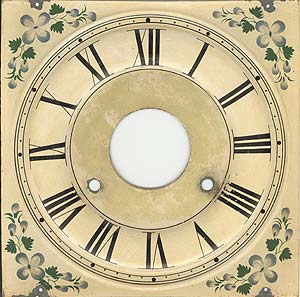The very earliest dials, ca. 1842 - 43 have two characteristics:


Ogee case, made in Plymouth Hollow, glasses puttied in.
Dial: metal, two rings drawn around time track, dots for minute marks.
Early features: tapered 3, 4 and 8, small winding holes (8.2 mm).
Early corner decorations with many brush strokes forming the small leaves.
Label: printed by Elihu Geer, Hartford, Connecticut, no address given. This dates it to 1842 - 1845


Dial: metal, two rings drawn around time track, dots for minute marks. Notice it has the same corner decorations the earliest wooden dial below.
Early features: tapered 3, 4 and 8, small winding holes (8.2 mm).
This dial was purchased with its original Seth Thomas movement at a flea market.


Ogee case, made in Plymouth Hollow, glasses puttied in.
Dial: metal, two rings drawn around time track, dots for minute marks.
Early features: tapered 3, 4 and 8, small winding holes (8.2 mm).
Label: printed by Elihu Geer, Hartford, Connecticut, no address given. This dates it to 1842 - 1845.
It is interesting that the earliest dials on the Seth Thomas one day brass clock were painted metal. Why did wooden dials appear for a short time around 1845? It may be that they were left over stock from the wooden movement clocks, which were discontinued in 1844 or 1845. This is the theory that Richard Tjarks and I have come up with, please if you can provide any information about this. If you have a Seth Thomas wooden movement ogee clock, so we can compare the dials and case.


Ogee case, original mirror lower glass, made in Plymouth Hollow, glasses puttied in.
Dial: wood, early type with two rings drawn around time track, dots for minute marks. Width 9 1/16", height 8 5/8".
Label: printed by Elihu Geer, Hartford, Connecticut, no address given. This dates it to 1842 - 1845.



Ogee case, made in Plymouth Hollow,glasses held with wood strips.
Dial: metal, two rings drawn around time track, dots for minute marks.
Early features: tapered 3, 4 and 8, small winding holes (8.2 mm).
Unusual feature: brass nameplate with S. THOMAS PLYMOUTH CONN U S A
Label: printed by Elihu Geer, Hartford, Connecticut, no address given. This dates it to 1842 - 1845.


Ogee case, replacement mirror (but it originally had a mirror), made in Plymouth Hollow, glasses held with wood strips.
Dial: wood, two rings drawn around time track, dots for minute marks. Width 8 1/2", height 8 9/32". (Has unusual feature of two rings drawn around the center opening.)
Label: printed by Elihu Geer, Hartford, Connecticut, 26 State Street. This dates it to 1845 - 1846.


Ogee case, made in Plymouth Hollow, glasses held with wood strips.
Dial: metal, one ring drawn around minute marks, dots for minute marks. Winding holes 9.8 - 10 mm diameter.
Label: printed by printed by Geo D. Jewett's Steam Job Card, and Book Printing House, 26 State Street Second Floor, Hartford, Conn. Probable date 1852.


Half column case type one, made in Plymouth Hollow, glasses held with wood strips. Tablet is a reproduction of the original (the original has all the paint missing, but a faint outline of the pattern was visible in the glass).
Dial: metal, one ring drawn around minute marks, dots for minute marks. Winding holes 9.3 mm diameter.
Label: Steam Press of Elihu Geer, No. 10 State Street, First Story, Hartford, Conn. Date 1850 - 55


Dial: metal, one ring drawn around minute marks, dots for minute marks.


Half column case type one, made in Plymouth Hollow, glasses held with wood strips.
Dial: metal, one ring drawn around minute marks, dots for minute marks.
Label: Steam Press of Elihu Geer, No. 10 State Street, First Story, Hartford, Conn. Date 1850 - 55


OG case, label printer missing.
Dial: metal, one ring drawn around minute marks, dots for minute marks.


Half column case type two, made
Dial: metal, one ring drawn around minute marks, dots for minute marks. Winding holes about 9.5 mm in diameter.
Label: Steam Press of Elihu Geer, 16 State Street, Hartford, Conn.
Dials have lines instead of dots for the minute marks.


Dial: metal, lines for minute marks, embossed chapter ring, painted corner decorations.
This type of dial introduced in late Plymouth Hollow era (ca. 1862?).

Dial: metal, lines for minute marks, embossed chapter ring, no corner decorations.
This type of dial is shown in the "1892 and 1893" Seth Thomas catalog (reprinted by Adams Brown, 1975).


Dial: metal, lines for minute marks, embossed chapter ring, no corner decorations, ST logo above "6". winding holes 10 mm diameter.
This type of dial is shown in the 1879 Seth Thomas catalog and in the 1884-5 Seth Thomas catalog (both reprinted by American Reprints Company).

Dial: metal, flat, printed, with ST logo below "12".
Late dial.
An article in the NAWCC Bulletin states that William B. Fenn, a dial and tablet painter, worked almost exclusively for Seth Thomas from 1840 to about 1863. It would be interesting to know if he painted some of the corner decoration in the earlier dials illustrated above.
"How To Do It, Let's Do Some Reverse Painting on Glass", Mrs. G. E. Vandervort, NAWCC Bulletin, Volume 10, No. 12, Whole Number 106, pp. 977 - 981.